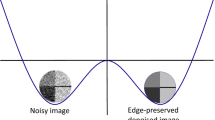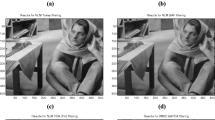Abstract
The non-local means (NLM) method and its variances have been proved to be effective for noise suppression. However, the traditional NLM method and its variances cannot guarantee to obtain a global optimum solution owing to a globally fixed bandwidth parameter for the entire image is used when computing similarity weight function. To address this problem, this paper proposes an adaptive NLM method based on a novel discontinuity indicator, which can get a good tradeoff between edge preservation and noise reduction. In our method, a novel discontinuity indicator based on the structure tensor is proposed, which can effectively distinguish edges from noises and smooth regions. Furthermore, the bandwidth parameter is adaptively chosen according to the proposed discontinuity indicator. As a result, the bandwidth parameter depends continuously on the local characteristic of each pixel. Experimental results demonstrate that our proposed method outperforms several mainstream methods.













Similar content being viewed by others
References
Afonso M, Sanches J (2015) A total variation recursive space-variant filter for image denoising. Digital Signal Processing 40:101–116
Brox T, Weickert J, Burgeth B, Mrazek P (2006) Nonlinear structure tensors. Image Vis Comput 24:41–55
Brox T, Kleinschmidt O, Cremers D (2008) Efficient nonlocal means for denoising of textural patterns. IEEE Trans Image Process 17:1083–1092
Budades A, Coll B, Morel J (2005) A review of image denosing algorithms, with a new one. Multiscale Model Simul 4:490–530
Deledalle C, Salmon J (2012) Non-local methods with shape adaptive patches (NLM-SAP). J. Math Imaging Vision 43:103–120
Emami A, Harandi M, Dagostar F (2015) Novelty detection in human tracking based on spatiotemporal oriented energies. Pattern Recogn 48(3):812–826
Hu C, Ye M, Ji S, Zeng W, Lu X (2015) A new face recognition method based on image decomposition for single sample per person problems. Neurocomputing 160:287–299
Lai R, Yang Y (2011) Accelerating non-local means algorithm with random project. Electron Lett 47:182–183
Mahmoudi M, Sapiro G (2005) Fast image and video denoising via nonlocal means of similar neighborhoods. IEEE Signal Process. Lett 12:839–842
Park S, Kang M (2010) NLM algorithm with weight update. Electron Lett 46:1061–1063
Salmon J (2010) On two parameters for denoising with non-local means. IEEE Signal Process Lett 17:269–272
Salmon J, Strozecki Y (2012) Patch reprojections for Non-local methods. Signal Process 92:477–489
Sutour C, Deledalle C, Aujol J (2014) ) Adaptive regularization of the NL-means: applications to image and video denoising. IEEE Trans Image Process 23(8):3506–3521
Tian H, Cai H, Lai J (2014) A novel diffusion system for impulse noise removal based on a robust diffusion tensor. Neurocomputing 133:222–230
Ulusoy I, Yuruk H (2014) New method for the fusion of complementary information from infrared and visual images for object detection. IET Image Process 5(1):36–48
Vignesh R, Oh B, Kuo C (2010) Fast non-local means (NLM) computation with probabilistic early termination,. IEEE Signal Process Lett 17:277–280
Ville D, Kocher M (2009) Sure-based non-local means. IEEE Signal Process Lett 16:973–976
Ville D, Kocher M (2011) Non-Local means with dimensionality reduction and SURE-based parameter selection. IEEE Trans Image Process 20:2683–2690
Wu Y, Tracey B, Natarajan P, Noonan J (2013) James-stein type center pixel weights for non-local means image denoising. IEEE Signal Process Lett 20:411–414
Xiong B, Yin Z (2011) A universal denoising framework with a new impulse detector and nonlocal means. IEEE Trans Image Process 21(4):1663–1675
Yan R, Shao L, Cvetkovic S, Klijn J (2012) Improved nonlocal means based on pre-classification and invariant block matching. J Disp Technol 8:212–218
Yang M, Liang J, Zhang J, et al. (2013) Nonlocal means theory based Perona-Malik model for image denoising. Neurocomputing 120:262–267
You Y, Kaveh M (2000) Fourth-order partial differential equations for noise removal. IEEE Trans. on Image Process 9:1723–1730
You X, Du L, Cheung Y (2010) A blind watermarking scheme using new nontensor product wavelet filter banks. IEEE Trans Image Process 19(12):3271–3284
Yu J, Tan J, Wang Y (2010) Ultrasound speckle reduction by a SUSAN-controlled anisotropic diffusion method. Pattern Recogn 43:3083–3092
Zeng W (2011) X. Lu Reigon-based non-local means algorithm for noise removal. Electron Lett 47:1125–1127
Zeng W, Lu X (2013) Local Structural Adaptive Total Variation Method for Image Restoration. J Imaging Sci Technol 57:20503–1–20503–5
Zeng W, Lu X, Tan X (2013) Non-linear fourth order telegraph-diffusion equation for noise removal. IET Image Process 7:335–342
Zhu Y, Zhao M, Zhao Y, Li H, Zhang P (2012) Noise reduction with low dose CT data based on a modified ROF model. Opt Express 20:17987–18004
Acknowledgments
The authors would like thank the Editor and anonymous reviewers for their helpful comments and constructive suggestions. This work was supported by the National Natural Science Foundation of China (61403081), the Natural Science Foundation of Jiangsu Province (BK20140638, BK20150793).
Author information
Authors and Affiliations
Corresponding author
Rights and permissions
About this article
Cite this article
Zeng, W., Du, Y. & Hu, C. Noise Suppression by Discontinuity Indicator Controlled Non-local Means Method. Multimed Tools Appl 76, 13239–13253 (2017). https://doi.org/10.1007/s11042-016-3753-z
Received:
Revised:
Accepted:
Published:
Issue Date:
DOI: https://doi.org/10.1007/s11042-016-3753-z




